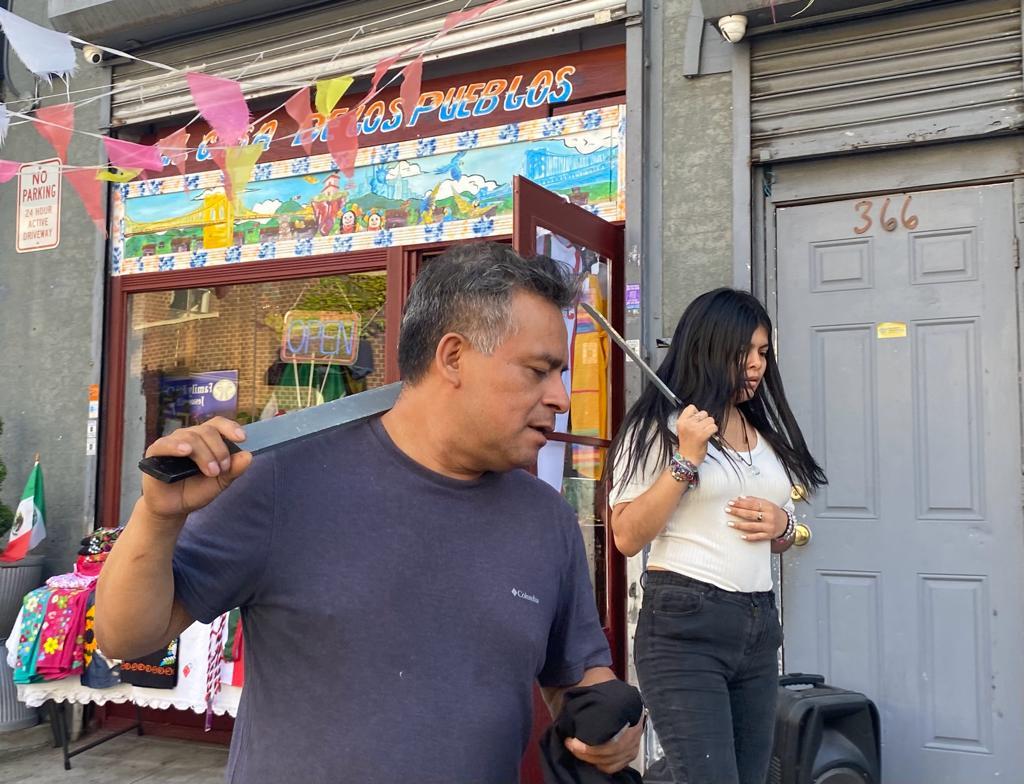They are thousands of miles away from the place they once called home, but a group of migrants and indigenous descendants from Mexico practice the dance of their native people in the South Bronx.
In the middle of the bustling streets of Mott Haven, indigenous migrant adults and children from the group Red de Pueblos Transnacionales gather on the sidewalk of East 146th Street, coordinating their steps to lively tunes played on drums and flutes.
The group, also known as “La Red,” is part of a Mott Haven-based nonprofit, La Casa de los Pueblos, that serves as a bridge to other resource organizations for migrants in New York. It is a space where indigenous migrants can find community through activities that include dance.
On this day, La Red dancers are practicing for their performance in the Mexican Independence Parade that takes place yearly in September.
“Culture, dance, in this sense, is a form of resistance for them,” explained La Red Executive Director Maria Ponce – resistance to what they have faced: “existing within this monster that is New York and everything they have to do like work hard, family and the different pressures they face daily.”
The dance is Las Moras, which emerged during the colonial era in Mexico. It is claimed by several indigenous communities in Puebla, including Teopantlán, home of some members of La Red, especially its co-founder and Nahuatl migrant, Esteban Estevez.
“That dance is unique there in Teopantlán. It is what is danced at all the patron saint festivals,” Estevez explained. “It is only danced twice a year. The patron saint’s festival used to be the festival of our ancestors, where our people would go to a hill and gather to ask the gods for rain and for their crops to turn out well.”
Estevez recognizes that Las Moras is very different from other dances of indigenous peoples due to the colonization that his community suffered. Dance forms the Spanish brought were imposed on the indigenous people and they mixed it with traditional moves, making it part of their identity.
Estevez brought the dance to celebrate his patron saint’s day with other Teoplatense migrants. And in 2017, when Estevez joined the Casa de los Pueblos collective and founded La Red, he introduced the dance to the group. Since then, La Red group has participated in several cultural events, including the Mexican Independence Parade, and this has helped them build a community, especially for the younger members of La Red.
“We have used dance to bring them closer to our roots, their grandparents and family,” he said. “We have also sent our children who were born here to Mexico, so that they know where we are from, where we come from and also so that they can value.”
City data shows that in 2020, 54.8% of Bronx residents were Hispanic/Latine, the highest percentage of any borough, and 30% identified as Hispanic/Latine migrants. In Mott Haven, headquarters of La Red, 68% of residents identify as Hispanic/Latine and up to seven languages are spoken by indigenous migrant residents – including Mam, Mixtec, Náhuatl, Otomí, Q’anjob’al, Tlapanec and Zapotec.
Language and dance are key ways that migrants and their descendants seek to preserve their roots, their own identity, and get closer to their culture.
Such is the case of Jaslyne Estevez, Esteban Estevez’s daughter, who at only 16 leads the Las Moras dance group and who, despite being the first generation born in the United States, can speak a little Nahuatl, the language of her father’s native people.
“I have been dancing for about eight to nine years. The dance steps were taught to me by my father and a friend of his who was from his town, from Teopantlán, Puebla,” said Jaslyne. She feels it is just as important to learn the language. “I want to continue learning Nahuatl so I can talk to my grandmother, because she speaks more Nahuatl than Spanish.”
A new member of La Red, Irma García, took leave from work to rehearse the dance in advance of the parade, and said she was excited to participate, even though the dance does not belong to her town of Tenextepango in Morelos, Mexico.
“You should never lose your culture, you should always be proud of who you are,” said García. “Let them see that there are many of us and we have many traditions to show.”

